Text
Freedom Road Reimagined
Freedom Road Re-Imagined
(2 April 2022, Rich Mix)
Performer: Sabina Desir: Photo by
Richard Birch

Many still cling to an incorrect assumption that the history of British people with African and Caribbean heritage is somehow secondary to that of their American counterparts.
Sabina Desir’s Rich Mix performance of Freedom Road Re-Imagined was a strong example of why it’s imprudent to lean into nationalist constructs as arbiters of entire cultures and histories. Freedom Road Re-Imagined covers important points in both the UK and US Civil Rights movements. Audio of landmark speeches was juxtaposed with, amongst others, well-known gospel, Rhythm & Blues, soul, and protest songs. Some of the most painful and visible incidents of Black History such as the lynching of Emmett Till, also feature, but there is much more besides.
Darcus Howe Supporters Outside The Old Baily, 1971@CHARLIE PHILLIPS WWW.NICKYAKEHURST.COM

We are presented with our own audio-visual Virgil in the form of Taariq Forder. Featured throughout the programme, his is an effective foil for Sabina Desir’s clarion tones, with both voices lending equal gravitas and humanity to the showcase without overshadowing any individual aspects of it.
The Performance at Rich Mix: Projection by Shaïny Vilo. Image by Richard Birch

A multi-ethnic lineup of musicians plays live throughout this immersive music performance, and on the night consisted of Winston Clifford on drums; Sabina Desir on vocals; Lascelle Gordon on percussion; Ivan Hussey on cello; Jessica Lauren on keyboards, Music Direction and Arrangements; Tamar Osborne on woodwinds and Jason Simpson on bass. These players all sounded truly in-the-pocket, and clearly respect each other as much as the subject matter they presented onstage for our consideration. The production has also been joisted by the jazz saxophone of Jason Yarde
Freedom Road on The Road: Projection: Vanley Burke. Photo: by Richard Birch,

Richard Birch had the responsibility of capturing the lightning of the electric performance in the lens of his camera on the night. And for the duration of the performance, the projected photography flows alongside film footage created by Nathan Jones.
Aside from that the acoustic artistry was augmented by the featured photography of Vanley Burke, Charlie Phillips and Shaïny Vilo, respectively.

There’s no question of going for the music or photography and staying for the history. The art and the facts are all inextricably intertwined on this occasion. A wealth of art underpins this performance, but no medium ever outshines another – such is the level of creative balance in this show.
Despite its monochrome nature, the photography also features quotidian scenes that illustrate the feeling of lively community, inner strength, depth, and humanity extant in people that the global media has long told others to avoid at all costs, along with their places of residence– long socially and politically maligned as no-go areas. There are gardens in certain Brixton estates that rival the more famous balconies and floral displays of the Barbican Estate. But how many know this? And if they don’t know, how can they learn if the media chooses not to highlight these social parallels? These details may seem small, but they point to the humanity (and impressive gardening skills) of Black Britons, and their steadfast dedication to finding their own way forward despite any adversity wilfully put in their path.
In one still image, smartly dressed, young Black boys huddle closely and smile for the camera. I wonder to myself whether these were smiles of innocence or of happy defiance– the latter shining through despite the social and economic strife many had either already witnessed at too young an age, or would eventually face as they matured from young Black boys to young Black men.
The Araldite that keeps this show together is Artistic Director and Producer Sabina Desir. Her sharp, dignified and protective gaze has been cast across each aspect of this work. Through careful consideration and curation, she and her team have successfully created a production that illustrates how deeply invested they are in the honest, clear and well-executed presentation of the history underpinning this multimedia art performance.
I came not to watch but to experience Freedom Road Re-Imagined. Those who care about the progress of the African Diaspora (more commonly referred to as ‘Black History’) are always hard-pressed to find objective and engaging presentations of this particular history. We dig deeply and fight hard for fair and honest depictions of Black History that serve to unite us, instead of accepting arbitrary attempts at division that shift focus to small differences such as geography and accents. The African Diaspora’s irrefutable global impact and components are as discrete as the myriad vessels that facilitated The Middle Passage. Therefore, indolent comparisons between the UK and US Civil Rights Movements, similar to those made betwixt baseball and cricket, only serve to highlight the idiocy of those relying upon them.
Onstage this evening, I did not see a show about The UK versus US Civil Rights Movements. I did see a special production possessing exceptional, creative, artistic and historical merit. Freedom Road Re-Imagined was neither mealy-mouthed nor confrontational in its approach. There was no finger pointing, shaming or blaming of other ethnicities. It was a poised presentation of historical facts, in a post-covfefe, post-pandemic paradigm.
It was the type of art and cultural work that facilitates meaningful, multi-dimensional communication, which will hopefully encourage extensive long-term dialogue on the history of Africans and Caribbeans in Britain, and their significance in global Black History overall.
I appreciate how Ms. Desir has managed to refer to key moments of Black History that speak to her personally, and present a vision on Black British History that is all her own. She needs no reliance upon Transatlantic cousins to help shape and share her chosen chapters of Black British History. Ms. Desir may be acknowledging a blueprint drafted by African Americans, but hers is a distinctly British production.

I cannot see through the eyes of others, least of all those of Freedom Road Re-Imagined’s Artistic Director and Producer Sabina Desir. Nor will it ever be possible for anyone to experience exactly how social conflict spanning several generations looks and feels for others. But being able to come along and witness someone else’s history is more than sufficient on this occasion.
Review by Malisa Ã. Elliott
3 notes
·
View notes
Text
Today In History:

A bit of January 31st history…
1863 - 1st black Civil War regiment, South Carolina volunteers, mustered into US army
1865 - US Congress passes 13th Amendment, abolishing slavery
1876 - US orders all Native Americans to move into reservations
1950 - US President Truman publicly announces support for development of a hydrogen bomb (pictured)
1985 - South African President PW Botha offers to free Nelson Mandela if he denounces violence
2019 - Colonization of the Americas in the late 1500′s killed so many people it cooled the planet and led to a “little ice age”, according to a scientific report published in “Quarternary Science Review”
2020 - UK finally withdraws from the European Union (Brexit)
3 notes
·
View notes
Photo

African freshwater catfish specimen
This freshwater catfish is Synodontis maculipinna. Synodontis is the most widely distributed genus of African freshwater catfish. This species, which is endemic to Tanzania, was collected from the Rufigi River near Lake Tanganyika, Tanzania. It arrived at the Natural History Museum, London, UK in 1922, and was classified and named by John Richardson Norman (1899-1944), an ichthyologist who worked at the museum. The original 1922 specimens include what is known as the type specimen.
5 notes
·
View notes
Text
LoSlavery Is Not OUR "Original Sin" The thick lines show majority of African slaves went to Spain’s (they started trans-Atlantic slave trade) Latin American & Caribbean slave colonies, Muslim and African Countries. Few went to colony that became the US

How many times have you heard that slavery was “America’s original sin”? I’m not quite sure what that means, but I think the idea is that slavery was a uniquely horrible thing that defines the United States and will stain whites forever. It’s one of the few things Senate Minority Leader Mitch McConnell and Barack Obama agree on. There are books about it. Here’s a college course at UC Davis called “Slavery: America’s Original Sin: Part 1."
The fact is, there has been slavery in every period of history, and just about everywhere. The Greeks and Romans had it, the ancient Egyptians had it, it’s all over the Bible, the Chinese and the pre-Columbian Indians had it, the Maoris in New Zealand had it, and the Muslims had it in spades. But I have never, ever heard of slavery being anyone else’s “original sin.”
About the only societies that never had slaves were primitivehunter-gatherers. As soon as people have some kind of formal social organization, they start taking slaves.
You’ve heard about slavery and mass human sacrifices of Central and South American Indians, but North American Indians were enslaving each other long before the white man showed up.
Tlingit and Haida Indians, who lived in the Pacific Northwest, went raiding for slaves as far South as California. About one quarter of the population were slaves, and the children of slaves were slaves. During potlatches, or huge ceremonial feasts, the Tlingit would sometimes burn property and kill slaves, just to show how rich they were. What’s a couple of slaves to a guy who lives in a house like this?
When we bought Alaska from the Russians in 1867, Indians were furious when we told them they had to give up their slaves. The Tlingit carved this image of Abraham Lincoln, the emancipator, to try to shame the government into compensating them for slaves.
What were called the Five Civilized Tribes of the American Southeast happily bought black slaves. In 1860, there were 21,000 Cherokee, and they owned 4,000 slaves. And that was just the Cherokee. Many took their slaves with them when they were forced to move West.
Free blacks in the South owned slaves. The fact of having been slaves didn’t stop them from wanting to be slave masters themselves. In 1840, in South Carolina alone, there were 454 free blacks who owned a total of 2,357 slaves. Only about 20 percent of Southern households had even one slave, but 75 percent of the free-black households in South Carolina owned slaves.
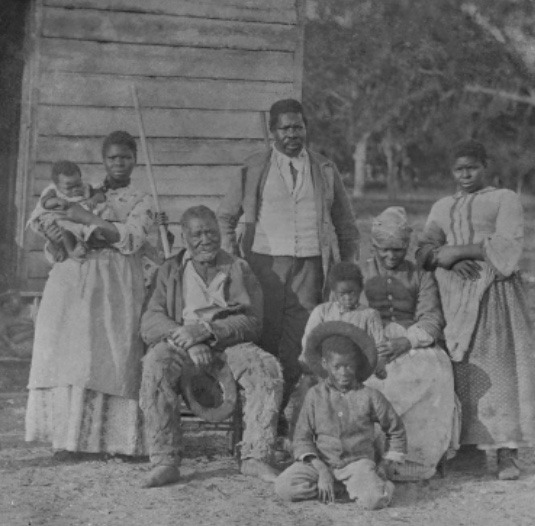

Don’t believe me? It’s all in this book by the expert on the subject, Larry Koger of the University of South Carolina. And he demolishes the idea that most blacks bought slaves only to get family members out of slavery. Like whites, some were kind masters and some were mean, but, for the most part, they owned slaves for exactly the same reasons whites did.

There’s a whole book about this black guy, Andrew Durnford.
He had a plantation of 672 acres along the Mississippi in Louisiana, and close to 100 slaves. Another black slave owner in Louisiana, P.C. Richards, owned 152 slaves. Black slaveowners avidly supported the Confederacy. There are no accurate estimates of the number of slaves held by free blacks at the time of the Civil War, but they would have been tens of thousands.
If slavery is somebody’s Original Sin, it’s sure not ours. Take a look at this map of the slave trade, beginning in 1500.

[Source: SlaveVoyages.com, click to enlarge]
The thicknesses of the lines represent numbers of slaves. What became the United States imported just around 400,000 slaves—about 3 percent of all the slaves who crossed the Atlantic. Look at all the slaves who went to Brazil and to the Caribbean Islands.They needed millions because, unlike American slaveowners who raised slave families, they bought grown men and worked them to death. And let us not forget, virtually every slave on this map was caught by blacks or Arabs.
And look at all the slaves who ended up in North Africa and the Middle East.
That’s millions of them going to Muslim countries at exactly the same time slaves were crossing the Atlantic. And Arabs had been taking black slaves out of Africa, across the Sahara, for 900 years before America was even discovered—and a forced march across the desert was a lot worse than crossing the Atlantic. In this article about Africa’s first slavers—the Arabs—historian Paul Lovejoy estimates that over the centuries, Muslims took about 14 million blacks out of Africa [Recalling Africa’s harrowing tale of its first slavers – The Arabs – as UK Slave Trade Abolition is commemorated, March 27, 2018]. That is more than the 12 million who went to the New World.
And you might ask, where are the descendants of all those Middle Eastern slaves? America has millions of slave descendants. Why don’t you see lots of blacks in Saudi Arabia or Syria or Iraq? Arabs castrated black slaves so they wouldn’t have descendants.

Muslims were even more enthusiastic about enslaving white people. Christian Slaves, Muslim Masters, by Prof. Robert C. Davis is the best book on the subject. Remember the Barbary Pirates of North Africa? Between 1530 and 1780 they caught and enslaved more than a million white, European Christians. During the 16th and 17th centuries, Arabs took more white slaves south across the Mediterranean than there were blacks shipped across the Atlantic.
Mostly, Muslim pirates captured European ships and stole their crews. In just three years, from 1606 to 1609, the British navy admitted it had lost 466 British merchant ships to North African pirates [Counting European Slaves on the Barbary Coast Past & Present, August 2001]. Four hundred sixty-six ships in just three years. Arabs took American slaves. Between 1785 and 1793 Algerians captured 13 American ships in the Mediterranean and enslaved the crews. This is a 1804 battle between Arab pirates and the USS Enterprise.

It was only in 1815, after two wars, that the United States was finally free of the Barbary pirates.
Muslim pirates also organized huge, amphibious slave-catching assaults that practically depopulated the Italian coast. In 1544, Algerian raiders took 7,000 slaves in the Bay of Naples in a single raid. This drove the price of slaves so low it was said you could “swap a Christian for an onion.”
After a 1566 raid on Granada in Spain netted 4,000 men women, and children, it was said to be “raining Christians in Algiers.” Women were easier to catch than men, and were prized as sex slaves, so some coastal areas lost their entire child-bearing populations. One raid as far away as Iceland brought back 400 white slaves.
Prof. Davis notes that the trade in black Africans was strictly business, but Muslims had a jihad-like enthusiasm for stealing Christians. It was revenge for the Crusades and for the reconquest of Spain from the Arabs in 1492. When Muslim corsairs raided Europe, they made a point of desecrating churches and stealing church bells. The metal was valuable but stealing church bells silenced the voice of Christianity.
It was a tradition to parade newly captured Europeans through the streets so people could jeer at them, while children threw garbage at them. At the slave market, both men and women were stripped naked to evaluate their sexual value. In the North African capitals—Tunis, Algiers, Tripoli—there was a big demand for homosexual sex-slaves. Other Europeans were worked to death on farms or building projects.
Prof. Davis writes that unlike in North America, there were no limits on cruelty: “There was no countervailing force to protect the slave from his master’s violence: no local anti-cruelty laws, no benign public opinion, and rarely any effective pressure from foreign states.” Slaves were not just property, they were infidels, and deserved whatever suffering a master meted out.
For a man, there was a fate even worse than being a sex slave. Hundreds of thousands became galley slaves, often on slave-catching pirate ships. They were chained to their oars 24 hours a day, and could move only to the hole where the oar went through the hull—so they could relieve themselves. If the men were rowing, they fouled themselves. Galley slaves lived in a horrible stench, ate rotten food, were whipped by slave drivers and tormented by rats and lice. They could not lie down and had to sleep at their oars. Many never left their ships, even in port. Their job was to row until they died, and to be tossed overboard at the first sign of weakness.
Muslims have taken slaves for as long as there have been Muslims, which is about 1,400 years.

Mohammed himself was an enthusiastic slave trader. Muslims still take black slaves. As this article points out, Libya still has slave markets, Mauritanian Arabs take black slaves, and there is still slavery in Niger, Mali, Chad and Sudan[Libya’s slave markets are a reminder that the exploitation of Africans never went away, by Martin Plaut, New Statesman, February 21, 2018].
And, of course, it was white people who abolished slavery, both in their own countries and, except for a few stubborn holdouts, the whole world. Africans, just like the Tlingit Indians, screamed about all the wealth we made them give up.
But slavery’s still our “original sin.” As Time magazine wrote just this month about slavery “Europeans and their colonial “descendants” in the United States engineered the most complete and enduring dehumanization of a people in history."[Facing America's History of Racism Requires Facing the Origins of 'Race' as a Concept, by Andrew Curran, July 10, 2020]
What a small minority of Americans did for 246 years—and in a relatively mild form—is worse than anything that was ever done anywhere by anyone.
That, ladies and gentlemen, is the power of white privilege. I hope you are enjoying it. Watch this video:
youtube
51 notes
·
View notes
Text
Look at the reference. so it ws just aliens after pick up and became a forever thing.
Madame Alexander Dolls




Dolls remain a popular collectible category, with top-notch antique, antique, and contemporary examples topping the wish lists of enthusiasts around the world. Amongst the category of dolls, Madame Alexander Dolls are the top of the list. Every July, the United Federation of Doll Clubs (UFDC), a 5013C organization at the forefront of doll research, education, conservation and appreciation, holds its annual convention. This gathering attracts attendees from all continents and is considered the most important annual event in the world of doll collecting. This year, due to COVID-19 restrictions, this celebration will be held online July 22-24 to keep everyone safe and healthy.
Perhaps the best known American brand of dolls are those designed and manufactured by Madame Alexander. Madame Dolls are always well represented at UFDC annual events. To learn more about these toys and collectibles, and what makes them so interesting from a collector’s, historical and design perspective, Auction Daily spoke with Diane McCarthy, former president of the Madame Alexander Doll Club.
Madame Alexander was born Bertha Alexander on March 9, 1895. When she grew up, she changed him to Beatrice, who seemed more elegant to her. Her parents emigrated from Russia and her father owned a doll hospital on New York’s Lower East Side. Beatrice and her father shared a passion for making and repairing dolls.
During World War I, there was an embargo on German products, including dolls, which affected the family business. Beatrice and her sisters teamed up to create dolls that they could sell, that would not break, and use available materials. The first models included a nurse and a doll. She would make a sample doll and her sisters would copy it. While they worked, Beatrice encouraged them and checked her work. This personal approach to high standards was a style she maintained throughout her career. As there were ups and downs in this journey, Madame Alexander dolls value was also affected, but now these dolls are at the top of all the dolls. Fans of these dolls are always attracted towards these dolls and their variety.
In 1923, Beatrice decided to start her own business with $ 1,600 in start-up money. She hired workers from her neighbourhood. Eventually, she was able to move into a studio in downtown Manhattan. Her time was divided between coming up with ideas for dolls, developing shop beads, and sewing. It was then that she learned to defend herself with male store owners looking to buy her dolls. FAO Schwarz was one of the first retailers to order with her.
Madame she was actively involved in all aspects of her business during the 75 years that she owned the company. However, she was smart enough to know that she couldn’t do everything. She convinced her husband, Philip, to leave her job and join her company. Philip took care of the unions, managed the shares, payroll and other operations and logistics of the company.
Madame was involved in product development and focused on popular culture for ideas. For example, she obtained a trademark for an Alice in Wonderland doll and made two versions, one of which she designed. When the movie Little Women came out in 1933, she presented a set of four dolls at the same time. After losing the rights to make a Shirley Temple doll, Madame obtained a license to produce the Dionne Quintets. She decided to act quickly on Scarlett O'Hara after reading Gone With the Wind before the film’s premiere in 1937. She was also in love with Princess Elizabeth and made a special doll to commemorate the coronation of her father.
She was also involved in production and engineering. After World War II, the company began developing a durable, hard plastic doll. It was important to Madame that her dolls were well made and practically unbreakable, as she felt that the dolls were meant to be played with. Using new DuPont technologies, she was able to upgrade her manufacturing so the company could use a face mold to create an infinite number of different styles. What she made these dolls so special were their unique outfits, high-end fabrics and trims, detailed painting, and accessories. She eventually won the Fashion Academy Gold Medal in 1951. She would earn it three times as much in the 1950s. This attention to detail was passed down to generations of designers and factory workers. The company’s motto became “Love is in the details” and is still printed on the doll’s hangtags today.
Media source: Auctiondaily
1 note
·
View note
Photo

A Royal Murder by Verity Bright (A Lady Eleanor Swift Mystery #9)
My Review (5*)
4,5* upped to 5
This is another gripping and highly entertaining instalment in this excellent series. The title could “Eleanor vs the Bright Young Thing” as we meet her dealing with a new friend who belongs the BYT set and she’s trying to turn Eleanor into a fashionable and silly lady.
Things do not work as expected and Eleanor is involved into another investigation.
I thoroughly enjoyed this story even if I found it a bit slow at the beginning. The investigation was exciting and I was happy to catch with the usual characters, Gladstone and Clifford above all.
The mystery is solid and full of surprises. The solution is unexpected and I appreciated how it work.
i cannot wait to read the next story and look forward to the evolution in the life of these beloved characters.
Highly recommended.
Many thanks to Bookouture and Netgalley for this ARC, all opinions are mine
Synopsis:
At the royal boat race there are beautiful barges, plenty of bunting, a handsome prince and… is that a body in the water? Lady Swift is on the case!
Spring, 1923. One-time adventurer and now amateur sleuth Lady Eleanor Swift is attending the annual royal regatta with her new pal Tipsy Fitzroy. Tipsy has Eleanor trussed up like a debutante in a new dress, determined to turn her into a proper society lady. Even Eleanor’s favourite companion, Gladstone the bulldog, has a new outfit for the occasion.
But the sparkling prize-giving ceremony is interrupted when the devilishly handsome host gulps his glass of champagne on stage and collapses to the floor. The victim is none other than the king’s cousin, Lord Xander Taylor-Howard. He was rumoured to be entangled in a rather dubious gambling ring, but did someone kill him instead of collecting his debt? Or was this simply an ill-timed tragic accident? Either way, a right royal scandal is afoot…
Sir Percival, the head of the royal police, asks Eleanor for her help investigating. He’d do anything to keep the story under wraps. She knows it will get her into hot water with a certain dapper Detective Seldon, but she’s determined to see justice done. However, as she digs deeper, she learns Lord Taylor-Howard was hiding more than one murky secret. It isn’t until she takes a closer look at the unfortunate royal’s shattered champagne flute that she stumbles upon just the clue she needs. But can she reel in the killer before her ship is sunk too?
The Author:
Verity Bright is the pseudonym for a husband-and-wife writing partnership that has spanned a quarter of a century. Starting out writing high-end travel articles and books, they published everything from self-improvement to humour, before embarking on their first historical mystery. They are the authors of the fabulous Lady Eleanor Swift Mystery series, set in the 1920s.
https://twitter.com/BrightVerity
Buy Link:
Amazon: https://geni.us/B09M3RYT22social
Audio:
UK: zpr.io/cyqVbRNRiSpk
US: zpr.io/pBxeLFqVYaB6
Listen to a sample here:
https://soundcloud.com/bookouture/a-royal-murder-by-verity-bright-narrated-by-karen-cass
2 notes
·
View notes
Text

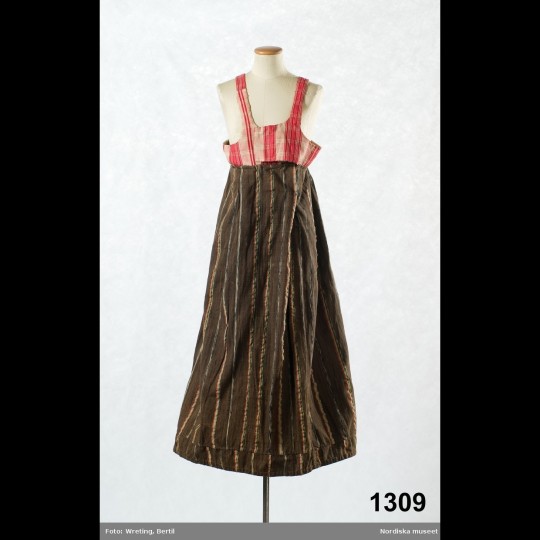
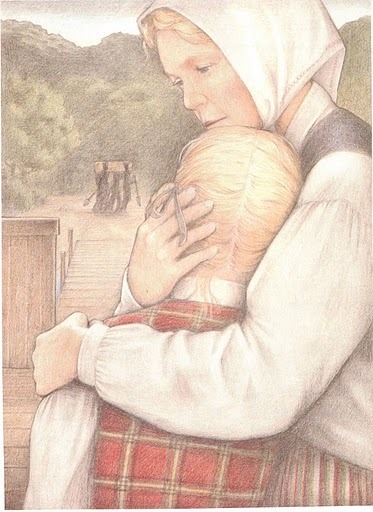
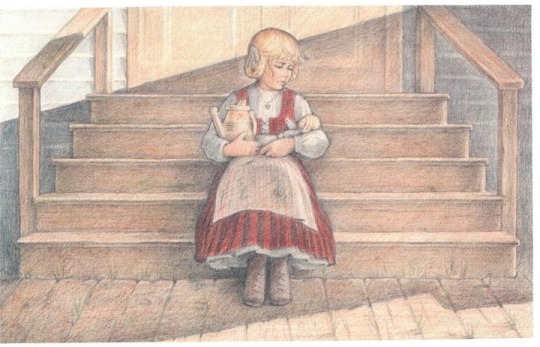
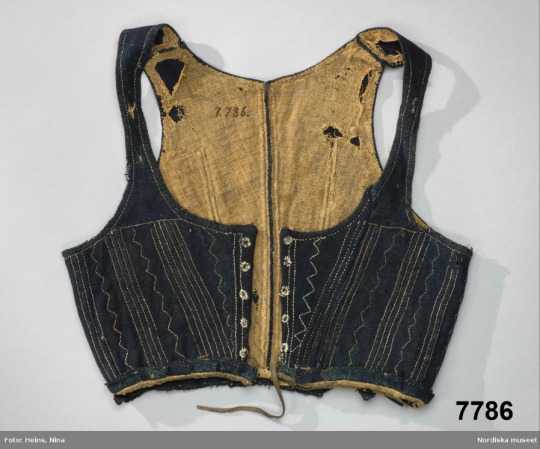
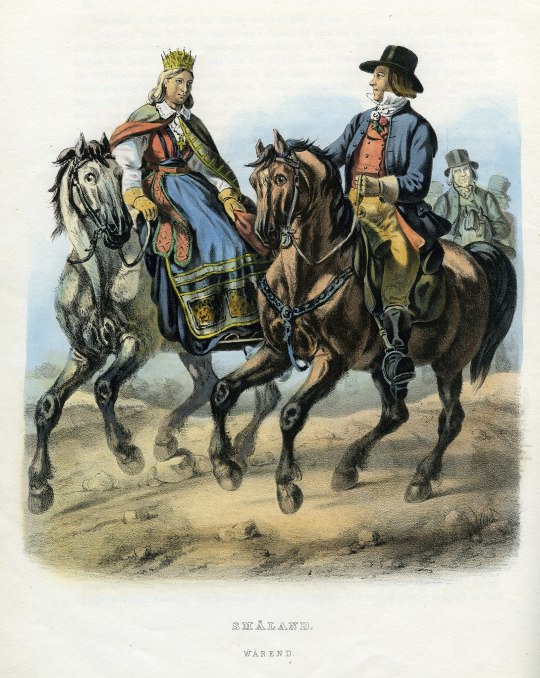
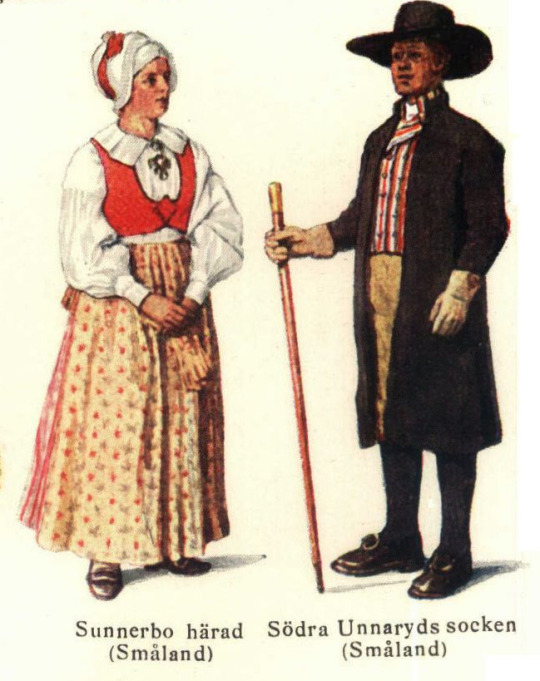

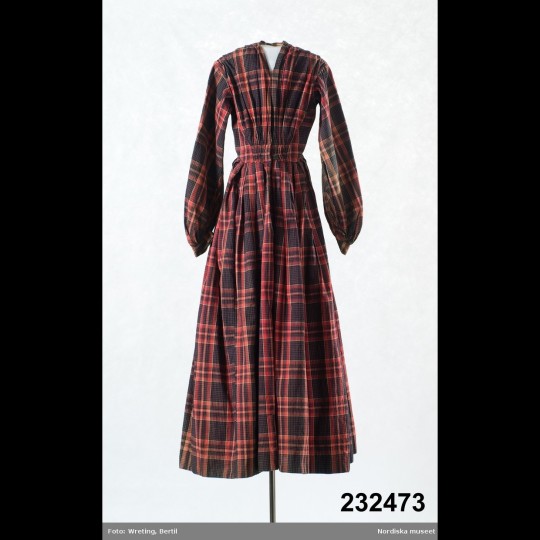
Kirsten's Swedish dirndl
Livkjol ("waist skirt"), circa 1700-1799, Nordiska museet
Livstycke (bodice), circa 1825-1850, Nordiska museet
Småland (Värend) from Svenska folkets seder, bruk och klädedrägter by Carl Anders Dahlström, 1863 via Wikimedia Commons
Folkdräkt (Värend), Nordisk familjebok vol.8 Folkdräkt, 1908, via Wikimedia Commons
Folkdräkt (Sunnerbo härad) and Folkdräkt, (Södra Unnaryds härad), Nordisk familjebok vol.8 Folkdräkt, 1908, via Wikimedia Commons
Klänning (dress), circa 1850-1860, Nordiska museet
The Mysteries of Kirsten’s Swedish Clothing - The Limits of Historical Research
This skirt with an attached bodice might be what Kirsten’s outfit was based on. You might think that since it dates to the 18th century, it is not accurate to what Kirsten would have worn in Sweden. The recorded examples of folkdräkt (“folk costume”) from the province of Småland are very similar, although it seems it was more common for bodices and skirts to be separate pieces. They appear to have similar construction and layering as working class clothing from 18th century England. There is an example of a bodice with rattan cane "boning" which would likely have taken the place of a corset for adult women but other examples from the same time period do not have this.
In the 1850s, even farmers like the Larsons were moving out of the folkdräkt and into more modern clothing. Folkdräkt is documented as being worn for special occasions like weddings and church holidays but made in finer fabrics like silk. The couple on horseback is a bride and groom. The modern clothing is simple, like the plaid dress shown here.
To add to the confusion, the designs of regional folkdräkt became more standardized to make them easier to replicate in the 20th century. For modern examples of folkdräkt from Småland, check out http://www.folkdrakt.se/bild/varend/varend.html. (The website owner has asked that pictures not be reposted).
Unfortunately, two books that would greatly increase my understanding of what Kirsten and her family would have worn in Sweden are both impossible to find in the United States, and only available in the Swedish language, although one of the books apparently has an English language index. (The books are Kvinnligt mode under två sekel by Britta Hammar and Pernilla Rasmussen, and Underkläder en Kulturhistoria by the same authors.)
And finally, dirndl is a German word!
190 notes
·
View notes
Photo




The celebrities wearing Chanel at the 2023 Met Gala
Penélope Cruz and Dua Lipa
Penélope Cruz, Co-chair for The Costume Institute Benefit and Chanel Ambassador, wore a custom long dress with a large shawl collar in light blue organza embroidered with silver sequins and a silver leather belt embellished with pearls inspired by look 81, from the Haute Couture Spring-Summer 1988 collection.
Dua LIpa, Co-chair for The Costume Institute Benefit, wore a long corseted dress in ivory wool tweed with a matching bolero jacket, look 97, from the Haute Couture Fall-Winter 1992 collection for the carpet. Chanel Chanel shoes.
Opening of The Costume Institute’s spring exhibition, “Karl Lagerfeld: A Line of Beauty”
READ MORE ARTICLE:
https://www.modadivasmagazine.com/en/2023/05/02/celebrities-chanel-2023-met-gala/
15 notes
·
View notes
Photo

The celebrities wearing Chanel at the 2023 Met Gala
Penélope Cruz and Dua Lipa
Penélope Cruz, Co-chair for The Costume Institute Benefit and Chanel Ambassador, wore a custom long dress with a large shawl collar in light blue organza embroidered with silver sequins and a silver leather belt embellished with pearls inspired by look 81, from the Haute Couture Spring-Summer 1988 collection.
Dua LIpa, Co-chair for The Costume Institute Benefit, wore a long corseted dress in ivory wool tweed with a matching bolero jacket, look 97, from the Haute Couture Fall-Winter 1992 collection for the carpet. Chanel Chanel shoes.
Opening of The Costume Institute’s spring exhibition, “Karl Lagerfeld: A Line of Beauty”
READ MORE ARTICLE:
https://www.modadivasmagazine.com/en/2023/05/02/celebrities-chanel-2023-met-gala/
15 notes
·
View notes
Photo

Celebrities wearing Chanel at the Chanel Cruise 2023/24 show
Angèle
Chanel Ambassador, wore a white cotton jacquard blouse with a black and silvery iridescent jacquard skirt, look 53, from the Fall-Winter 2023/24 Ready-to-Wear pre-collection. Chanel accessories, bag and shoes. Chanel Make Up .
READ MORE ARTICLE:
https://www.modadivasmagazine.com/en/2023/05/16/celebrities-chanel-cruise-2023-24/
5 notes
·
View notes













